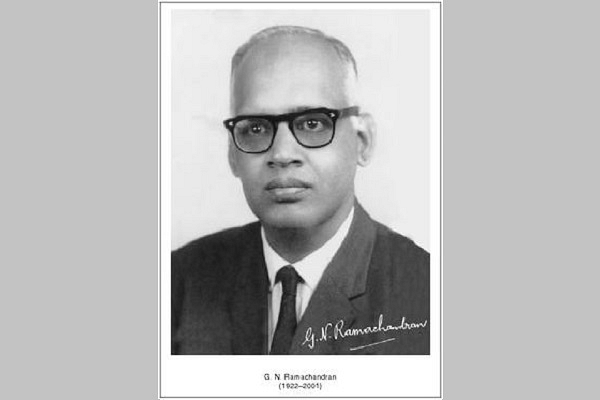Science
G N Ramachandran: The Great Indian Scientist And Vedantin
- Great Indian physicist G N Ramachandran died on this day 17 years ago.
- Behind the triple helix model and the Ramachandran plot, he put Madras on the map of science, but sadly, not many remember him today.

Indian physicist G N Ramachandran (Current Science/Wikimedia Commons)
An auspicious morning is one when you see a tweet like this from the Science and Technology Minister Dr Harsh Vardhan on one of the greatest and yet least sung savants of science in India – Professor G N Ramachandran.
One is thankful to the minister for reminding the nation of this great scientist. In Chennai, where there are ample statues of all sorts of political demagogues, Ramachandran is remembered through an almost nondescript building inside Madras University – perhaps symbolic of our failings.
Life of biophysicist Ramachandran is as inspiring as it is melancholic. Of course, his research was not rooted in Indian philosophy as such. But he was interested in building an Indic approach to the philosophy of science. To that, we shall come later.
That Ramachandran was a brilliant physicist with great potential for contribution to global science was recognised by then vice-chancellor of Madras University, Lakshmanaswamy Mudaliar. After all, it was physicist C V Raman who had recommended the young physicist in his place when Mudaliar wanted the veteran physicist for Madras University.
That’s how Ramachandran ended up in Madras University, where he became the founder and head of the physics department at the early age of 29. Mudaliar treated him as his son and made sure that there were neither administrative nor financial constraints to the work of Ramachandran, writes professor M Vijayan, INSA Albert Einstein Research Professor.
Till 1969, the year Mudaliyar retired, Ramachandran had no problem in doing his research in Madras. But after that, his life became a tale of two cities as he shuttled between Madras and Bangalore.
Ramachandran put Madras on the map of Indian science when he, along with Gopinath Kartha, proposed the triple helix structure for the collagen molecule. The work was published in Nature magazine in 1955. He co-authored this paper with Kartha. Co-discoverer of the structure of the DNA molecule, Francis H C Crick, however, opposed the proposed structure saying that though the “idea” was “basically correct”, “the actual structure suggested by them to be wrong”. But the model, now famous as the ‘Madras triple helix model’, was vindicated, though Ramachandran was never given his rightful place of honour for the discovery.
Though the initial objections raised on the surface against the proposed structure looked scientific, that there was also prejudice at work, cannot be discounted. Biophysicist professor Vijayan explains:
Ramachandran eventually moved from the collagen work to what became one of the most important contributions to the field of biophysics. Today it is known as the Ramachandran plot.
Dr Chaitanya Giri, astromaterials and planetary scientist with Earth Life Science Institute (ELSI) points out in his tweet in honour of Ramachandran, how as a biophysicist he was fascinated by the “simplicity of a 2D graphical Ramachandran plot in describing the 3D protein structures”.
There was a Vedantist deep inside Ramachandran, the scientist. His biographer Raghupathy Sarma points out:
He was fascinated by Syadvada and Saptabhangi of Jain philosophy. In 1982, he wrote a paper in the journal Current Science, depicted below.
It is interesting to see that Ramachandran, who used mathematics in biological problems, was also inspired in the same way as did many Indian mathematicians, like Ramanujan, who saw himself looking into the divinity through mathematics. One can deduce from the passage (below) which he had written for his ‘Vedanta and Epistemology’, that his search for mathematical models to understand reality stems from a deep civilisational conviction of seeing mathematics as an expression of Brahman itself.
It is amazing to see the continuity in Indian thought in the domain of scientific approach to reality. More than eight centuries before Ramachandran, celebrated mathematician Bhaskaracharya, expressing the paradoxical nature of the concept of infinity, said that there was no change in khahara (term for infinity) by addition or subtraction, and likened it to the divine being unaltered by the appearance of entities coming into existence and leaving at the time of universal cycles of creation and dissolution (Bija-Ganita 2:20).
So, what is the legacy of Ramachandran? Perhaps the words of Vijayan summarise the achievements of the life of this seer – a life that was incredibly great in the annals of science:
Forgotten by Tamil Nadu, Ramachandran nevertheless put the name of Madras honourably on the atlas of world science. A fallen Tamil Nadu is unable to remember the greatness of its great son. Once again, thanks Dr Vardhan for remembering this man.
Support Swarajya's 50 Ground Reports Project & Sponsor A Story
Every general election Swarajya does a 50 ground reports project.
Aimed only at serious readers and those who appreciate the nuances of political undercurrents, the project provides a sense of India's electoral landscape. As you know, these reports are produced after considerable investment of travel, time and effort on the ground.
This time too we've kicked off the project in style and have covered over 30 constituencies already. If you're someone who appreciates such work and have enjoyed our coverage please consider sponsoring a ground report for just Rs 2999 to Rs 19,999 - it goes a long way in helping us produce more quality reportage.
You can also back this project by becoming a subscriber for as little as Rs 999 - so do click on this links and choose a plan that suits you and back us.
Click below to contribute.
Latest